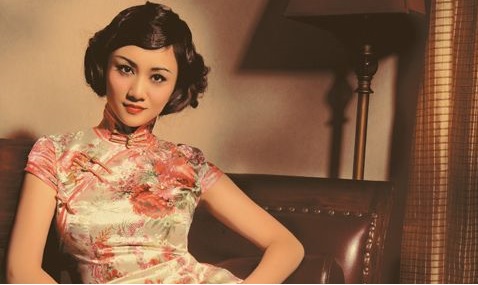You may know the qipao as that skintight cocoon of a dress that only seems to fit the slenderest figure – and that’s before lunch. Sure, the modern qipao packs its fair share of intimidation into each snug thread, yet historically, the dress was not meant to daunt the female physique but flatter it. A mathematically sound design proven to idealize each and every curve of a woman, the qipao can be striking on any body type if tailored correctly. Timeless and intricate, a traditional customized qipao requires no less than 24 physical measurements before it can be crafted correctly. Below, we dissect every last inch of the mysterious design that has captivated suitors for centuries.
 Neckline: Tradition favors a high mandarin collar, but it all depends on the shape of one’s neck. Long, slim necks are best accentuated with a high neckline and three knotted buttons, while those with shorter necks will find a lower collar more flattering.
Neckline: Tradition favors a high mandarin collar, but it all depends on the shape of one’s neck. Long, slim necks are best accentuated with a high neckline and three knotted buttons, while those with shorter necks will find a lower collar more flattering.
Fastens: There are over 100 different styles of knotted buttons, called ‘frog closures,’ and each has a unique symbolic meaning. The most intricate frog designs are generally used for special occasions and can take at least two full days to make by hand. A single qipao should only feature one style – apparently the Manchus weren’t into mixing and matching – while the total number of buttons on the collar and chest traditionally sum to an odd number for artistic touch.
Closures: Frog closures should always lead from the collar to the right underarm and down to the upper right thigh. Don’t fall for modern qipaos that carelessly sew buttons onto the left side! If you’re going for a classic look, stick with what’s called an ‘S closure’ (pictured here) instead of contemporary styles like the halter, keyhole or slit closure.
Sleeves: One of the defining elements of the qipao, the length of sleeves will either attract or distract curious onlookers. Those with long, slender arms or narrow shoulders should consider cap sleeves, while robust builds may opt for half-sleeves that end at the elbow.
Side Fastens: On a traditional qipao, every knotted button is real or ‘living’ (活扣), as one Chinese term puts it. These buttons should be the only thing that holds the garment onto the body, no zippers or seams allowed! A vital part of the overall look of a qipao, real buttons allow the dress to breathe with a woman’s movement – the taut fabric will expand and contract in sync with one’s motions instead of lying stiff against the body.
Slit: The sexiest part of this conservative dress, the slit can be made high, medium or low, depending on how risque a look one is going for. The highest slit makes the legs appear longest and usually hits at mid-thigh, revealing just enough to spark the imagination without causing a scene.
Length: Like all dresses, height warrants a longer style. If you are on the shorter side, try for a qipao that hits just above the knee. Traditional qipaos were generally longer, falling to the shin or ankle, though the latter are often worn for more formal occasions.
Fabric: Choice of material doesn’t just change with the seasons. A fabric’s pattern, shine, texture and direction of print can draw attention to certain parts of the body. Those with slim, boyish frames can use silk brocade or velour to create dimension through the shine of the fabric and bring about the illusion of curves, while those with a more buxom figure can use small vertical facing prints to appear trimmer.
Color/Design: Red is typically reserved for weddings, as is the phoenix print. Pastel pink is difficult to pull off without looking like a Hello Kitty mascot, but don’t jump to darker shades too quickly – the colors in a qipao traditionally deepen with a woman’s age. For a symbol of purity, go with the lotus. A peony denotes honor and wealth; chrysanthemums are for the cheerful and plump fish are said to promise an influx of cash.






















0 User Comments